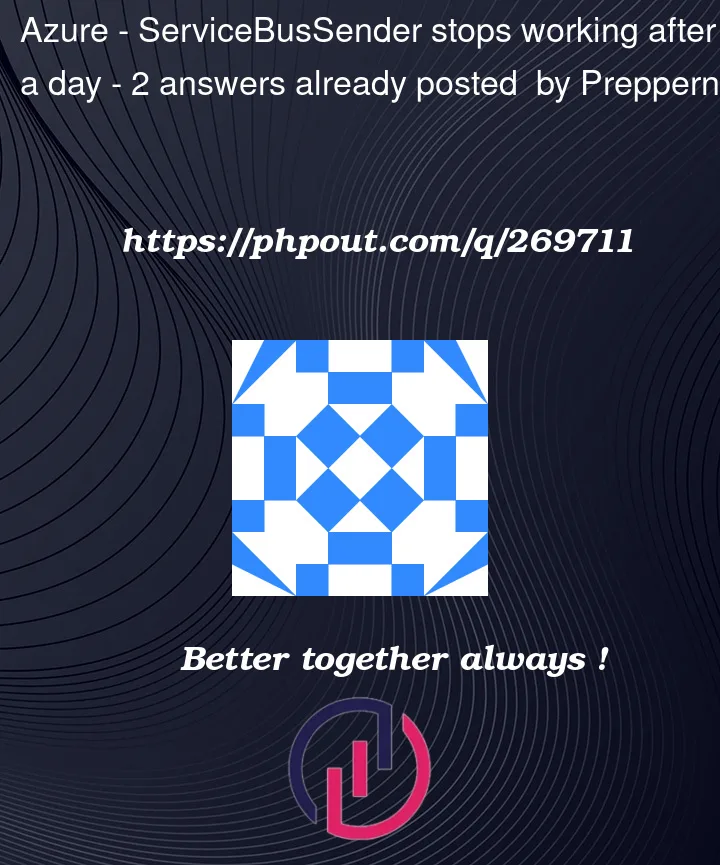I’m struggeling with a Azure ServiceBusSender which is executed in a Azure Function Http endpoint.
It works fine for about a day. Then suddenly it will throw the following error and I will have to restart the azure function:
System.Exception: A connection attempt failed because the connected party did not properly respond after a period of time, or established connection failed because connected host has failed to respond. ErrorCode: TimedOut (ServiceCommunicationProblem). For troubleshooting information, see https://aka.ms/azsdk/net/servicebus/exceptions/troubleshoot.
If I restart the azure functions, it will continue to work for about a day.
Utilizing the Azure.Messaging.ServiceBus 7.16.1
Depency injection:
builder.Services.AddAzureClients(clientsBuilder =>
{
clientsBuilder.AddServiceBusClient(appConfig.GetValue<string>("CRMSBActivityConnectionString"))
.ConfigureOptions(options =>
{
options.RetryOptions.Delay = TimeSpan.FromMilliseconds(50);
options.RetryOptions.MaxDelay = TimeSpan.FromSeconds(5);
options.RetryOptions.MaxRetries = 3;
});
clientsBuilder.AddClient<ServiceBusSender, ServiceBusClientOptions>((_, _, provider) =>
provider.GetService<ServiceBusClient>().CreateSender(appConfig.GetValue<string>("CRMSBActivityTopicName")
)).WithName("SBSender");
});
Http endpoint:
private IServiceLogger _logger;
private const string _commonMessage = "SMSActivityStopGetHttpListenerV1:";
private readonly ServiceBusSender _sender;
public SMSActivityStopGetHttpListener(IServiceLogger logger, IAzureClientFactory<ServiceBusSender> serviceBusSenderFactory)
{
_logger = logger;
_sender = serviceBusSenderFactory.CreateClient("SBSender");
}
[ProducesResponseType((int)HttpStatusCode.Accepted)]
[ProducesResponseType((int)HttpStatusCode.InternalServerError)]
[ProducesResponseType((int)HttpStatusCode.BadRequest)]
[FunctionName("SMSActivityStopGetHttpListenerV1")]
public async Task<HttpResponseMessage> Run(
[HttpTrigger(AuthorizationLevel.Function, "get", Route = "v1/smsactivity/stop")] HttpRequest req,
ILogger log)
{
//Simple logic
try
{
await _sender.SendMessageAsync(servicebusMessage);
}
catch (Exception ex)
{
response = new HttpResponseMessage(HttpStatusCode.InternalServerError) { Content = new StringContent(errorMessage, Encoding.UTF8, "application/json") };
SplunkLogger.LogExceptionToSplunk(_logger, _commonMessage, null, correlationId, "SMSActivityStop API failed", ex.Message);
}
return response;
}
Tried to update the packages. removed all sorts of extra details from the functions. But the problem persists.
Stops working after one day even with very few requests. less than twenty.




2
Answers
I tried your code in my environment and got the same error below.
I made some changes to your code and received the message sent to the Service Bus Queue in Azure Portal.
Code :
local.settings.json :
Note : Make sure that you have a stable Internet connection before going to run the above code.
Output :
It runs successfully and sends a message to the service bus queue.
Below is the output from the browser:
Azure Portal :
I got the message in my Service Bus Queue in Azure Portal as below:
All senders and receivers can be created using the injected into function
IAzureClientFactory<ServicBusCient>factory object. This object acts as a singleton to avoid re-establishing the connection to the namespace as it’s an expensive operation. Senders and receivers use the connection maintained by theServiceBusClientand are cheap to create and dispose on demand.